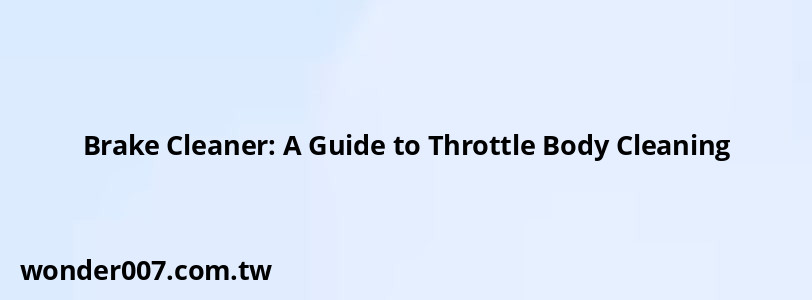Brake Cleaner: A Guide to Throttle Body Cleaning

Using brake cleaner on a throttle body is a topic of considerable debate among automotive enthusiasts and professionals. This guide will clarify whether it's appropriate to use brake cleaner for this purpose, the potential risks involved, and the best practices for maintaining your vehicle's throttle body.
Can You Use Brake Cleaner on the Throttle Body?
Yes, you can use brake cleaner on the throttle body, but with caution. Brake cleaner is effective at removing grime and carbon deposits due to its powerful solvent properties. However, it is crucial to avoid spraying it directly onto sensitive components like sensors, as some formulations can be harmful if exposed to heat or combustion.
Pros of Using Brake Cleaner
- Effective Cleaning: Brake cleaner can dissolve tough grime and carbon buildup quickly.
- Rapid Evaporation: It evaporates quickly, which reduces drying time and minimizes moisture introduction into the engine.
- Residue-Free: Most brake cleaners leave no residue behind, ensuring that the throttle body remains clean after application.
Cons of Using Brake Cleaner
- Potential Damage: Some brake cleaners may damage rubber or plastic components within the throttle body.
- Lack of Lubrication: Unlike specialized throttle body cleaners, brake cleaner does not contain lubricants, which are beneficial for moving parts.
Best Practices for Cleaning the Throttle Body
To ensure safe and effective cleaning of your throttle body using brake cleaner, follow these guidelines:
1. Work in a Well-Ventilated Area: Ensure proper ventilation to avoid inhaling harmful fumes from the brake cleaner.
2. Wear Protective Gear: Use gloves and safety glasses to protect against chemical exposure.
3. Remove the Throttle Body if Possible: For thorough cleaning, consider removing the throttle body from the vehicle. This allows for better access and minimizes the risk of contaminating other engine components.
4. Avoid Sensitive Areas: Do not spray brake cleaner directly onto sensors or electrical connections.
5. Use Sparingly: Apply brake cleaner in moderation to prevent excessive buildup that could lead to engine issues.
6. Follow Up with a Specialized Cleaner: After using brake cleaner, consider finishing with a throttle body cleaner that contains lubricants for optimal maintenance.
Alternatives to Brake Cleaner
If you are concerned about using brake cleaner on your throttle body, consider these alternatives:
- Throttle Body Cleaner: Specifically formulated for cleaning throttle bodies, these products often contain lubricants that help maintain moving parts.
- Carburetor Cleaner: Similar to throttle body cleaners but may not be suitable for all applications due to their harsher chemicals.
- Soap and Water Mixture: For light cleaning, a mild soap solution can be effective without risking damage to sensitive components.
FAQs About Using Brake Cleaner on Throttle Bodies
FAQs About Brake Cleaner and Throttle Bodies
- Is it safe to use brake cleaner on a running engine?
No, it is not recommended to spray brake cleaner into a running engine as it can produce toxic fumes. - How often should I clean my throttle body?
It is generally recommended to clean the throttle body every 30,000 to 50,000 miles or when performance issues arise. - Can cleaning the throttle body improve fuel efficiency?
Yes, a clean throttle body can enhance airflow and combustion efficiency, potentially leading to better fuel economy.
In conclusion, while you can use brake cleaner on a throttle body with caution, it's essential to be aware of its limitations and potential risks. Following best practices will help ensure that your vehicle's performance remains optimal without causing damage to sensitive components.
Related Posts
-
Hyundai Sonata Radio Display Troubleshooting Guide
27-01-2025 • 185 views -
Belt Tensioner: Essential Guide for 2012 Hyundai Sonata Hybrid
27-01-2025 • 136 views -
Cabin Air Filter Replacement: 2016 Hyundai Tucson Guide
28-01-2025 • 185 views -
Jeep Grand Cherokee Window Switch Problems: Troubleshooting Guide
27-01-2025 • 167 views -
Ford 5.8 Coolant Temp Sensor Housing: Essential Guide
29-01-2025 • 158 views
Latest Posts
-
How To Turn Off Paddle Shifters Mercedes
01-02-2025 • 336 views -
Power Steering Fluid Leak On Passenger Side
01-02-2025 • 421 views -
Rear Brake Caliper Piston Won't Compress
01-02-2025 • 317 views -
2015 Chevy Traverse AC Recharge Port Location
01-02-2025 • 368 views -
Are O2 Sensors Covered Under Warranty
01-02-2025 • 341 views
Popular Posts
-
Power Steering and ABS Light On: Causes and Solutions
27-01-2025 • 617 views -
Hino Warning Lights: Understanding Dashboard Alerts
26-01-2025 • 643 views -
V12 Engine Costs: What You Need to Know
26-01-2025 • 638 views -
EPC Warning Light: What It Means for Your Vehicle
27-01-2025 • 595 views -
EPC Light: Understanding Causes and Solutions
26-01-2025 • 1020 views
